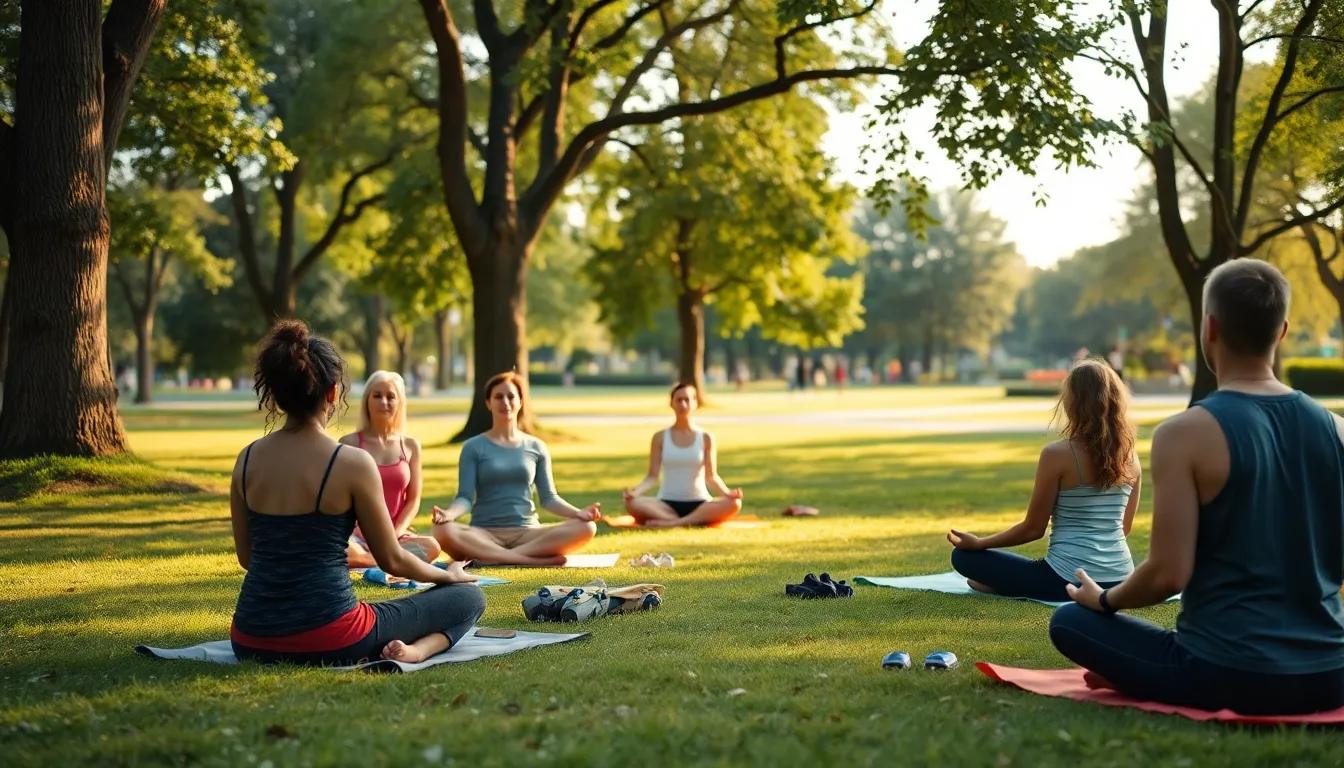Table of Contents
ToggleIn a fast-paced world filled with distractions, the concept of mindful living has gained significant traction. It encourages individuals to embrace the present moment, fostering a deeper connection with themselves and their surroundings. By practicing mindfulness, one can cultivate awareness and appreciation for life’s simple pleasures, leading to enhanced well-being.
Mindful living isn’t just about meditation; it encompasses everyday activities like eating, walking, and even conversations. By incorporating mindfulness into daily routines, individuals can reduce stress and improve their overall quality of life. This article explores the principles of mindful living and offers practical tips for integrating mindfulness into everyday experiences, helping readers transform their lives one moment at a time.
Understanding Mindful Living
Mindful living focuses on being fully present and engaged in each moment. This practice enhances well-being and fosters a deeper appreciation for experiences.
Definition of Mindful Living
Mindful living encompasses the intentional practice of awareness in daily activities. It means paying attention to thoughts, feelings, and surroundings without judgment. This approach promotes a sense of calm and clarity, influencing emotional responses and reducing stress levels. Activities such as eating, walking, and interacting with others can become opportunities for mindfulness.
Historical Context and Origins
Mindful living traces its roots back thousands of years, primarily linked to Buddhist traditions. Ancient teachings emphasized meditation and awareness as pathways to enlightenment. The term “mindfulness” gained prominence in the West during the late 20th century, largely due to Jon Kabat-Zinn’s work. In 1979, he introduced mindfulness-based stress reduction (MBSR), integrating traditional mindfulness practices into modern healthcare. This shift highlighted the practical benefits of mindfulness, such as improved mental health and emotional resilience.
Benefits of Mindful Living

Mindful living offers numerous benefits that enhance overall well-being. From improved mental health to stronger relationships, mindfulness touches various aspects of life.
Mental Health Advantages
Practicing mindfulness reduces symptoms of anxiety and depression. It cultivates emotional regulation, leading to increased resilience against life’s challenges. Regular mindfulness meditation lowers cortisol levels, which contributes to stress reduction. Studies show that individuals who engage in mindfulness practices report improved focus and clarity in daily tasks.
Physical Health Benefits
Mindful living promotes healthier lifestyle choices. Individuals practicing mindfulness often choose nutritious foods and engage in regular physical activity. Research indicates that mindfulness can lower blood pressure and improve sleep quality. Mindful breathing techniques enhance lung capacity, providing a greater sense of relaxation.
Social and Relationship Improvements
Mindfulness enhances communication and empathy in relationships. Practicing mindfulness during interactions fosters deeper connections and understanding. Individuals notice improved conflict resolution skills and reduced reactivity to stressful situations. These practices create a supportive environment that strengthens personal and professional relationships.
Practices for Mindful Living
Mindful living involves various practices that enhance awareness and promote a present-focused mindset. Here are key techniques that support this lifestyle.
Meditation Techniques
- Guided Meditation: Involves following verbal instructions from a teacher or a recording, allowing individuals to focus on thoughts and sensations.
- Body Scan: Encourages awareness by mentally scanning the body from head to toe, identifying areas of tension and promoting relaxation.
- Loving-Kindness Meditation: Cultivates compassion by silently repeating phrases that express goodwill toward oneself and others.
- Mindfulness Sitting: Focuses on the breath while sitting, fostering calmness and a non-judgmental observation of thoughts as they arise.
Breathing Exercises
- Deep Breathing: Involves inhaling deeply through the nose, filling the lungs, then exhaling slowly through the mouth, promoting relaxation.
- 4-7-8 Breathing: Consists of inhaling for four seconds, holding the breath for seven seconds, and exhaling for eight seconds, effectively calming the nervous system.
- Box Breathing: Engages inhaling, holding, exhaling, and holding again for equal counts (often four), providing a structured approach to regulate breath.
- Belly Breathing: Focuses on expanding the diaphragm rather than the chest, encouraging full breaths that enhance oxygen intake and relaxation.
Incorporating Mindfulness into Daily Activities
- Mindful Eating: Encourages savoring flavors and textures of food while minimizing distractions, enhancing appreciation of meals.
- Mindful Walking: Involves paying attention to each step and the sensations in the feet, promoting awareness of the environment.
- Mindful Listening: Focuses on being fully present during conversations, leading to deeper connections and improved understanding.
- Mindful Chores: Involves focusing on the physical sensations and repetitive actions during tasks like washing dishes or folding laundry, transforming mundane tasks into mindful practices.
These practices foster mindfulness and support overall well-being, making it easier to live in the present moment while enhancing life quality.
Challenges in Practicing Mindful Living
Mindful living presents challenges that can hinder the development of awareness and presence. Understanding these obstacles can facilitate a smoother journey towards incorporating mindfulness into daily routines.
Common Obstacles
- Busy Lifestyles: Juggling numerous responsibilities often leads to a rushed mindset. Individuals may struggle to allocate time for mindfulness practices amid their packed schedules.
- Impulsiveness: Reacting habitually to situations can disrupt mindful awareness. It often takes deliberate effort to pause and respond thoughtfully instead of reacting instinctively.
- Emotional Resistance: Uncomfortable emotions may surface during mindfulness practices. Some individuals resist facing these feelings, as they prompt discomfort or anxiety, creating a barrier to mindfulness.
- Lack of Understanding: Misconceptions about mindfulness might deter individuals from earnest practice. A belief that mindfulness only means meditation may limit engagement with various mindful living activities.
- Inconsistent Practice: Establishing a steady mindfulness routine is challenging. Without regularity, benefits may diminish, leading to frustration and disengagement.
Overcoming Distractions
- Designated Spaces: Create a dedicated area for mindfulness practice. This space should be free from distractions and conducive to focus, enhancing the ability to engage fully.
- Scheduled Time: Set specific times for practicing mindfulness. Consistency reinforces habit-building, making it easier to integrate mindfulness into daily life.
- Mindful Technology Use: Limit distractions from devices by setting notification boundaries. Using technology intentionally helps maintain focus and reduces interruptions during mindfulness exercises.
- Breath Awareness: Employ breath awareness as an anchor during distractions. Focusing on the breath can refocus thoughts and return the individual to a present state of mind.
- Gradual Progression: Start with shorter mindfulness sessions and gradually extend them. This reduces the overwhelming feeling of committing to long practices, making mindfulness more accessible.
Resources for Mindful Living
Various resources can enhance the practice of mindful living. The following recommendations include books, literature, apps, and online courses to support individuals in their journey toward mindfulness.
Books and Literature Recommendations
- “The Miracle of Mindfulness” by Thich Nhat Hanh: This foundational text offers practical techniques and insights from a leading figure in mindfulness, encouraging readers to embrace presence in everyday life.
- “Wherever You Go, There You Are” by Jon Kabat-Zinn: This accessible guide breaks down the principles of mindfulness, making it suitable for both beginners and experienced practitioners.
- “Mindfulness in Plain English” by Bhante Henepola Gunaratana: This book provides clear explanations of mindfulness meditation, focusing on how to cultivate awareness and clear the mind.
- “Radical Acceptance” by Tara Brach: This work combines mindfulness with self-compassion, helping readers accept difficult emotions and situations.
- “The Mindful Way Through Depression” by Mark Williams, John Teasdale, Zindel Segal, and Jon Kabat-Zinn: This book addresses how mindfulness can help combat depression through practical exercises and insights.
Apps and Online Courses
- Headspace: This popular app offers guided meditations and mindfulness exercises, catering to various levels of experience. Users can find sessions focused on stress reduction, sleep improvement, and more.
- Calm: Known for its soothing interface and nature sounds, Calm provides guided meditations, sleep stories, and relaxation techniques beneficial for daily mindfulness practice.
- Mindful Schools: This organization offers online courses specifically designed for both adults and children, teaching mindfulness skills in a structured format.
- Insight Timer: This app features thousands of free meditations and courses from various mindfulness teachers, allowing users to customize their practice experience.
- Coursera and Udemy: Both platforms offer a variety of online courses on mindfulness, including those created by esteemed universities and qualified instructors, enhancing the practice of mindfulness through structured learning.
These resources serve to deepen understanding and practice of mindful living, providing valuable tools to reduce stress and promote overall well-being.
Embracing mindful living can profoundly transform daily experiences and overall well-being. By cultivating awareness and presence in every moment individuals can discover deeper connections with themselves and others. This intentional practice not only enhances mental and physical health but also fosters a greater appreciation for life’s simple joys.
As the journey towards mindfulness unfolds it’s essential to remain patient and compassionate with oneself. Each small step taken towards integrating mindfulness into daily routines contributes to a richer and more fulfilling life. With the right tools and commitment anyone can navigate the challenges of modern living while nurturing a mindful approach that leads to lasting peace and clarity.




